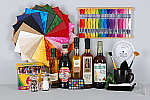 Nikon D40 shots up + Shooter's Report
Nikon D40 shots up + Shooter's Report
By
Shawn Barnett
(Saturday, November 18, 2006 - 23:13 EST)
We spent a little extra time Friday and Saturday working on the D40 test shots. I went out and grabbed some galleries and Luke did some lab work to get you sample images from our production D40.
I had a good time shooting with the D40 and D80 at the same time. The D40 has a great quality feel and is fun to shoot with. I could easily see it as a wonderful take-everywhere SLR, though every time I switched back to the D80, I was more at home and felt the difference. That big, bright viewfinder on the D80 really makes everything better, and its 18-135mm lens is so versatile.
I love that the D40 has big, bright red LEDs as AF indicators, as I've always been dissatisfied with the dim LCD/LED combo on the other Nikon SLRs. There are only three AF points, but since I usually lock the sensor to the middle one, it's not a big concern. I'm also happy to see that silly screen protector gone. Like the Rebel XT and XTi, the grip is a bit small, but I do like how both the camera's body and lens feel higher quality. And I've never heard a more polite-sounding shutter mechanism. The Nikon D40 is a class act.
Because the D40 tends to blow out the highlights far more than the D80 (and much more like the D50), I spent a lot of time adjusting the EV setting. This pointed up an odd bug in the LCD status display. In both Graphic and Classic display modes, the bars on the EV indicator were very slow to move when I pressed the EV button and turned the dial. At first I would move it again, thinking my motion hadn't registered, but inevitably it would catch up and move to -0.7 instead of the -0.3 EV I'd intended. There's an LED indicator in the viewfinder, and there's no delay there. Not sure what's up, but I'm already ready to suggest that all D40 users just keep their little SLRs set to -0.3EV or less by default.
Much as I understand Nikon's only selling the camera bundle in the US, I'm a little concerned given the significant lens flare I saw with the new lens. For the worst example of this, see the Nikon D40 Gallery and look in the upper right hand corner of image YDSC_0011.JPG. The white on black text just goes wild there. I saw it later on some white stones on a brown background as well. It's not everywhere, but it does affect areas of strong contrast.
Since I shot both the D80 and D40 galleries together, you have a rare opportunity to see how both cameras perform with their different lenses shot on the same day, just seconds apart. (When looking at the D80 Gallery in comparison to the D40 shots, be sure to see the images after and including YDSC_2501.JPG, because those were shot on 11/17, while the others were shot on 11/1).
Which reminds me: the D80 gallery shots are also worth close perusal, because though I stand by my statement that the D80's 18-135mm kit lens is an excellent and versatile lens, it also produces some of the most dramatic chromatic aberration I've ever seen (see YDSC_2504.JPG). You'll see distinct lines of red on one side and blue on the other where there are sudden changes in contrast, especially at wide angle, but often everywhere. It's not at all unexpected on a lens of this type, where they're really pushing the limits, but you should give it a look before committing to this lens. True, two zooms that cover the same range would require a lens change, but you'll usually get better pictures.
To see what the Nikon D40 (and D80 for that matter) can do without its 18-55mm II kit lens, check out our test shots as well, most of which were shot with our benchmark Nikon 105mm prime lens. Though this is an older body-driven Nikon AF lens, it does work via manual focus (meaning that the aperture does stop down), and the camera will tell you when you've reached a point of sharp focus.
Look for a full user report soon. Meanwhile, keep checking back as we continue our thorough testing of the Nikon D40 digital SLR. (Incidentally, check out the high ISO shots from the Still Life target. Impressive.)
--Shawn Barnett
|